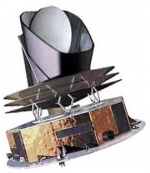Displaying items by tag: Planck spacecraft
Planck Space Observatory
Planck — a Cosmic Microwave Background explorer, after COBE & WMAP. launched in may 2009.
Planck is a space observatory of the European Space Agency (ESA) and designed to observe the anisotropies of the cosmic microwave background (CMB) over the entire sky, at a high sensitivity and angular resolution. Planck was built in the Cannes Mandelieu Space Center by Thales Alenia Space and created as the third Medium-Sized Mission (M3) of the European Space Agency's Horizon 2000 Scientific Programme. The project, initially called COBRAS/SAMBA, is named in honour of the German physicist Max Planck (1858–1947), who won the Nobel Prize for Physics in 1918.
Planck was launched in May 2009, reaching the Earth/Sun's L2 Lagrangian point in July, and by February 2010 had successfully started a second all-sky survey. Preliminary data from these surveys have been released, and results are said to indicate that the data quality is excellent. Planck is expected to yield definitive data on a number of astronomical issues by 2012. The mission will complement and improve upon observations made by the NASA Wilkinson Microwave Anisotropy Probe (WMAP), which has measured the anisotropies at larger angular scales and lower sensitivity than Planck. Planck will provide a major source of information relevant to several cosmological and astrophysical issues, such as testing theories of the early universe and the origin of cosmic structure.
The mission has a wide variety of scientific aims, including:
- High resolution detections of both the total intensity and polarization of the primordial CMB anisotropies
- Creation of a catalogue of galaxy clusters through the Sunyaev-Zel'dovich effect
- Observations of the gravitational lensing of the CMB, as well as the integrated Sachs–Wolfe effect
- Observations of bright extragalactic radio (active galactic nuclei) and infrared (dusty galaxy) sources
- Observations of the Milky Way, including the local interstellar medium, distributed synchrotron emission and measurements of the galactic magnetic field.
- Studies of the local Solar System, including planets, asteroids, comets and the zodiacal light.


































